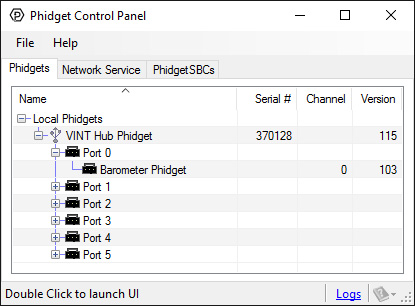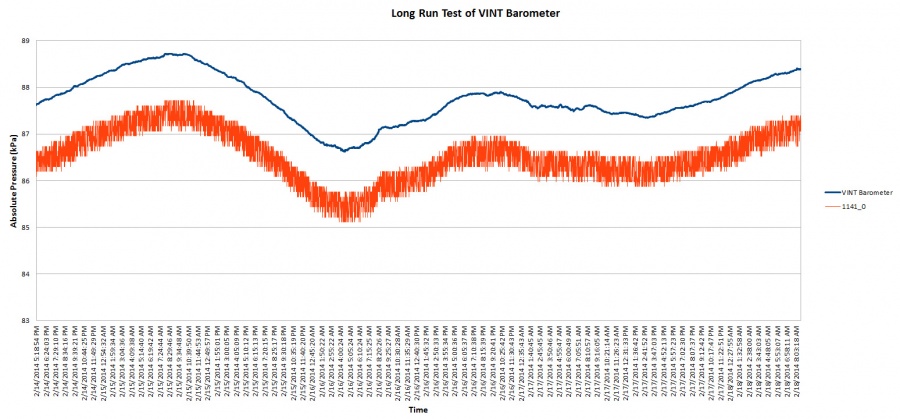
The Barometer Phidget is an air pressure sensor. With this Phidget you can read absolute pressure. It’s great for calculating accurate atmospheric pressure. This Phidget connects to your computer through a VINT Hub.
This Phidget is a smart device that must be controlled by a VINT Hub. For more information about VINT, have a look at the VINT Overview page. You can use a Phidget Cable to simply and easily connect the two devices. Here's a list of all of the different VINT Hubs currently available:
| Product | Board Properties | |||
|---|---|---|---|---|
| Part Number | Price | Number of VINT Ports | VINT Communication Speed Max | Controlled By |
 VINT Hub Phidget
|
$40.00 | 6 | 1 Mbit/s | USB (Mini-USB) |
 1-Port VINT Hub Phidget
|
$24.00 | 1 | 1 Mbit/s | USB (USB-A) |
 VINT Hub Phidget
|
$35.00 | 6 | 1 Mbit/s | USB (Mini-USB) |
 VINT Hub Phidget
|
$30.00 | 6 | 100 kbit/s | USB (Mini-USB) |
 Wireless VINT Hub
|
$60.00 | 6 | 100 kbit/s | Local Network (Ethernet or Wi-Fi) |
 PhidgetSBC4
|
$120.00 | 6 | 100 kbit/s | — |
Use a Phidget cable to connect this device to the hub. You can solder multiple cables together in order to make even longer Phidget cables, but you should be aware of the effects of having long wires in your system.
| Product | Physical Properties | |
|---|---|---|
| Part Number | Price | Cable Length |
 Phidget Cable 10cm
|
$1.50 | 100 mm |
 Phidget Cable 30cm
|
$1.75 | 300 mm |
 Phidget Cable 60cm
|
$2.00 | 600 mm |
 Phidget Cable 60cm
|
$2.00 | 600 mm |
 Phidget Cable 90cm
|
$2.00 | 900 mm |
 Phidget Cable 120cm
|
$2.25 | 1.2 m |
 Phidget Cable 150cm
|
$2.50 | 1.5 m |
 Phidget Cable 180cm
|
$2.75 | 1.8 m |
 Phidget Cable 350cm
|
$3.00 | 3.5 m |
 Phidget Cable Kit
|
$10.00 | 80 mm |
 Phidget Cable Extension Wire 22AWG
|
$0.75/Meter | — |
The Barometer Phidget measures absolute pressures within the range of 50kPa and 110kPa at a resolution of 250 mPa. If you read air pressures outside this range, an error event will trigger.
You can use your Control Panel to explore your Phidget's channels.
1. Open your Control Panel, and you will find the following channel:

2. Double click on the channel to open the example program. This channel belongs to the PressureSensor channel class:
In your Control Panel, double click on "Barometer Phidget":

Before you open a Phidget channel in your program, you can set these properties to specify which channel to open. You can find this information through the Control Panel.
1. Open the Control Panel and double-click on the red map pin icon:

2. The Addressing Information window will open. Here you will find all the information you need to address your Phidget in your program.

See the Phidget22 API for your language to determine exact syntax for each property.
Note: Graphing and logging is currently only supported in the Windows version of the Phidget Control Panel.
In the Phidget Control Panel, open the channel for your device and click on the ![]() icon next to the data type that you want to plot. This will open up a new window:
icon next to the data type that you want to plot. This will open up a new window:

If you need more complex functionality such as logging multiple sensors to the same sheet or performing calculations on the data, you'll need to write your own program. Generally this will involve addressing the correct channel, opening it, and then creating an Event Handler and adding graphing/logging code to it.
The quickest way to get started is to download some sample code for your desired programming language and then search google for logging or plotting in that language (e.g. "how to log to csv in python") and add the code to the existing change handler.
You can perform filtering on the raw data in order to reduce noise in your graph. For more information, see the Control Panel Graphing page.
You can perform a transform on the incoming data to get different graph types that may provide insights into your sensor data. For more information on how to use these graph types, see the Control Panel Graphing page.
The Change Trigger is the minimum change in the sensor data needed to trigger a new data event.
The Data Interval is the time (in ms) between data events sent out from your Phidget.
The Data Rate is the reciprocal of Data Interval (measured in Hz), and setting it will set the reciprocal value for Data Interval and vice-versa.
You can modify one or both of these values to achieve different data outputs. You can learn more about these properties here.
Firmware Upgrade
MacOS users can upgrade device firmware by double-clicking the device row in the Phidget Control Panel.
Linux users can upgrade via the phidget22admin tool (see included readme for instructions).
Windows users can upgrade the firmware for this device using the Phidget Control Panel as shown below.

Firmware Downgrade
Firmware upgrades include important bug fixes and performance improvements, but there are some situations where you may want to revert to an old version of the firmware (for instance, when an application you're using is compiled using an older version of phidget22 that doesn't recognize the new firmware).
MacOS and Linux users can downgrade using the phidget22admin tool in the terminal (see included readme for instructions).
Windows users can downgrade directly from the Phidget Control Panel if they have driver version 1.9.20220112 or newer:

Firmware Version Numbering Schema
Phidgets device firmware is represented by a 3-digit number. For firmware patch notes, see the device history section on the Specifications tab on your device's product page.

The PRE1000 reports the absolute pressure of its surroundings; in other words, the pressure compared to a perfect vacuum. If you plan on using this sensor as a barometer, you need to convert to barometric pressure. You can use conversion calculators such as this above sea level barometer reading correction calculator to make the adjustment based on your location's elevation.
Since the PRE1000 makes absolute pressure measurements, you could use it with a temperature sensor to measure changes in altitude, as long as you know your pressure and height to begin with. The following is the barometric formula:
where
This formula can be rearranged for as follows:
A long-run test was performed to compare the accuracy of the PRE1000 with that of the 1141 - Absolute Gas Pressure Sensor. For 87 hours, both sensors measured the absolute air pressure indoors in the same room, with the same change sensitivity.

As you can see, the PRE1000 is significantly less noisy. The average difference between any two successive samples for the 1141 is 237.17Pa, while for the PRE1000, it is 3.19Pa. Both sensors consistently differ by an average of 1.23kPa, but this error could be easily calibrated out due to the consistency of the offset.
| Board Properties | |
|---|---|
| Controlled By | VINT |
| VINT Communication Speed Max | 10 kbit/s |
| Sensor Properties | |
| Sensor Type | Gas Pressure (Absolute) |
| Pressure Min | 50 kPa |
| Pressure Max | 110 kPa |
| Pressure Resolution | 250 mPa |
| Pressure Noise Max | * 5 Pa |
| Sampling Interval Max | 60 s/sample |
| Sampling Interval Min | 100 ms/sample |
| Electrical Properties | |
| Current Consumption Min | 25 μA |
| Current Consumption Max | 4 mA |
| Physical Properties | |
| Operating Temperature Min | -40 °C |
| Operating Temperature Max | 85 °C |
| Customs Information | |
| Canadian HS Export Code | 9026.20.00 |
| American HTS Import Code | 9026.20.40.00 |
| Country of Origin | CN (China) |
| Date | Board Revision | Device Version | Comment |
|---|---|---|---|
| June 2017 | 0 | 104 | Product Release |
| Channel Name | API | Channel |
|---|---|---|
| Barometer | PressureSensor | 0 |
| API | Detail | Language | OS | |
|---|---|---|---|---|
| PressureSensor | Visual Studio GUI | C# | Windows | Download |
| PressureSensor | JavaScript | Browser | Download | |
| PressureSensor | Objective-C | macOS | Download | |
| PressureSensor | Swift | macOS | Download | |
| PressureSensor | Swift | iOS | Download | |
| PressureSensor | Visual Basic | Windows | Download | |
| PressureSensor | Max | Multiple | Download |
| Product | Sensor Properties | ||||||
|---|---|---|---|---|---|---|---|
| Part Number | Price | Sensor Type | Pressure Min | Pressure Max | Pressure Differential Min | Pressure Differential Max | Pressure Resolution |
 Barometer Phidget
|
$15.00 | Gas Pressure (Absolute) | 50 kPa | 110 kPa | — | — | 250 mPa |
 Absolute Air Pressure Sensor 15-115 kPa
|
$30.00 | Gas Pressure (Absolute) | 15 kPa | 115 kPa | — | — | 111 Pa |
 Absolute Air Pressure Sensor 20-400 kPa
|
$30.00 | Gas Pressure (Absolute) | 20 kPa | 400 kPa | — | — | 413 Pa |
 Differential Air Pressure Sensor ± 25kPa
|
$30.00 | Gas Pressure (Differential) | — | — | -25 kPa | 25 kPa | 55 Pa |
 Differential Air Pressure Sensor ±2 kPa
|
$30.00 | Gas Pressure (Differential) | — | — | -2 kPa | 2 kPa | 5 Pa |
 Differential Air Pressure Sensor ±7 kPa
|
$30.00 | Gas Pressure (Differential) | — | — | -7 kPa | 7 kPa | 17 Pa |
 Differential Air Pressure Sensor 50 kPa
|
$32.00 | Gas Pressure (Differential) | — | — | 0 Pa | 50 kPa | 56 Pa |